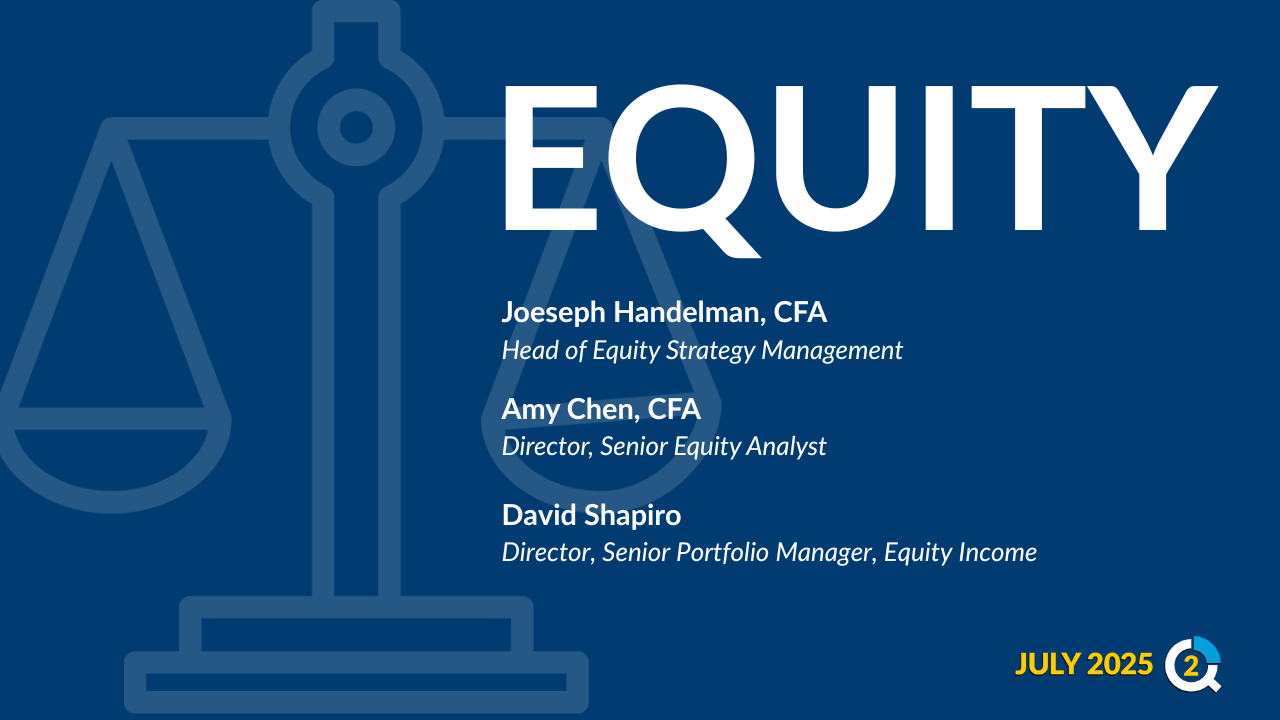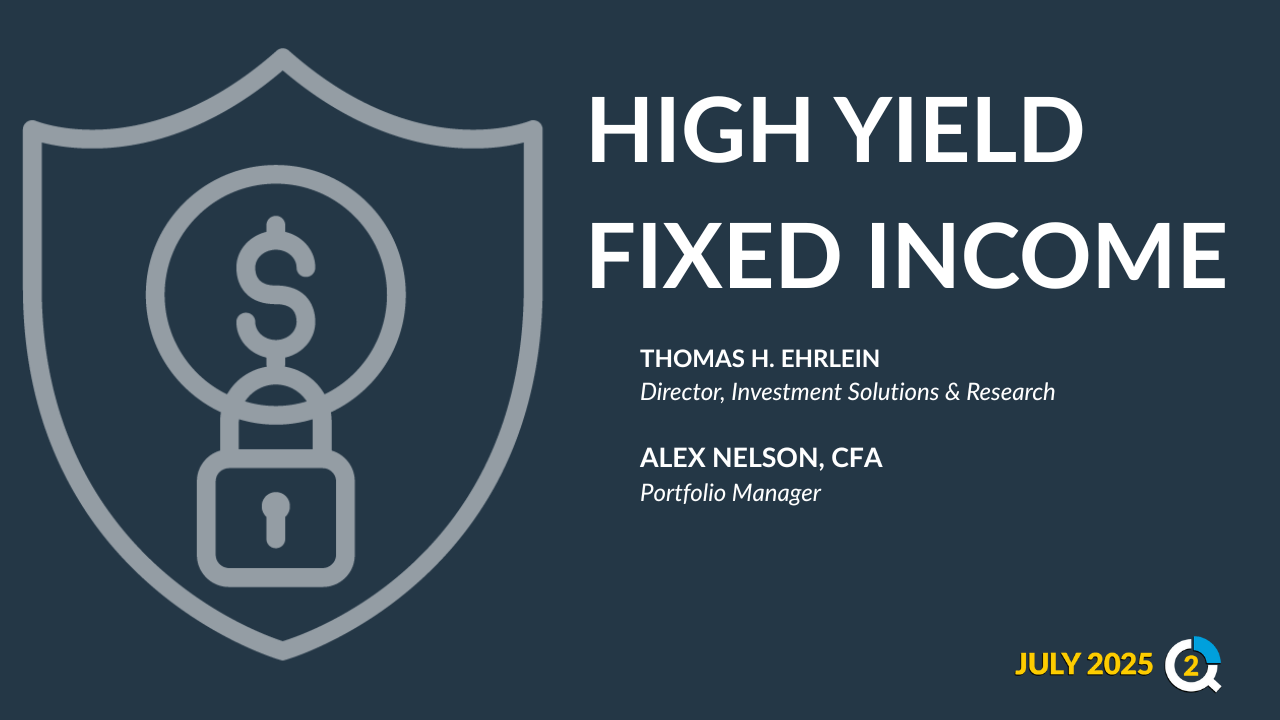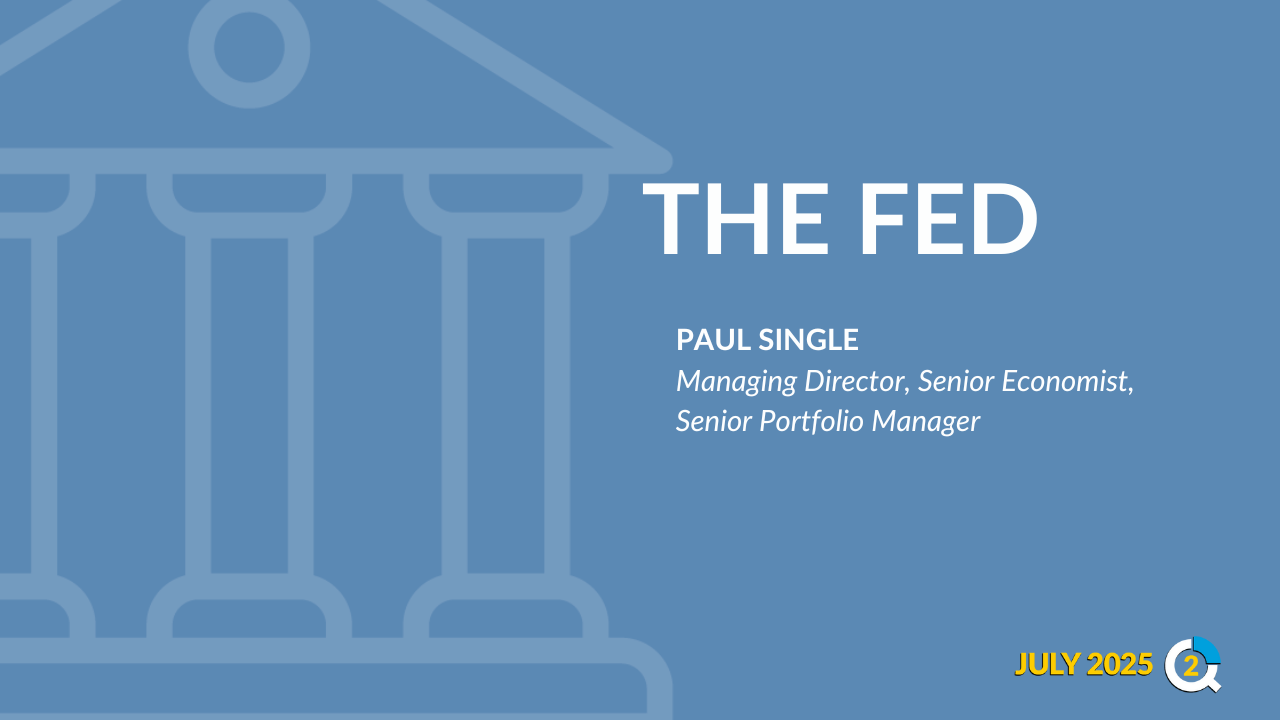
Second Half of 2025 Outlook: A Market Balancing Act After an Eventful Start
July 23, 2025
The first half of 2025 delivered no shortage of volatility, testing investor resolve while ultimately rewarding investors who maintained composure and stayed in the market.
The equity market drawdown that bottomed in April — nearly breaching bear market territory with a peak-to-trough decline of over 19% — was triggered by the Trump administration’s announcement of reciprocal tariffs. Markets also endured the sustained geopolitical friction in Eastern Europe and weathered a re-escalation of Middle East tensions and military actions. The global policy backdrop, once again unsettled, challenged assumptions around inflation persistence, supply chain resilience and earnings durability.
And yet, just as sentiment appeared to be unraveling, markets staged a notable reversal. The S&P 500 rallied sharply into midyear, finishing June up 6.2% year to date, lifted by better-than-expected inflation and employment data, as well as increased policy clarity from Washington. Treasury yields stabilized, credit spreads narrowed, volatility moderated, and many of the worst-case scenarios embedded in asset prices proved too dire.
Still, the rally has left investors facing a familiar puzzle: How much optimism is already priced in, and what risks remain underappreciated?
A Shift in Policy — and Its Market Implications
The centerpiece of the policy landscape heading into the second half of the year is the passage of the “One Big Beautiful Bill” (OBBB), which was signed into law on July 4, the president’s deadline. While the political theater surrounding the bill’s path was no small contributor to earlier market volatility, its final form delivered more continuity than upheaval. Most notably, the OBBB makes the individual tax cuts enacted in the 2017 Tax Cuts and Jobs Act (TCJA) permanent, thereby avoiding what would have amounted to a large, broad-based tax hike on businesses and consumers starting in 2026.
Corporate provisions, including extensions to bonus depreciation and R&D incentives, could bolster investment spending, particularly among capital-intensive industries. In that sense, the bill may modestly support earnings growth over the next 12 to 18 months. However, markets will also have to reckon with its longer-term implications: The legislation lifts the debt ceiling to $40 trillion and raises questions about upward pressure on yields as fiscal borrowing accelerates.
The net impact of the bill is still to be determined, but at a minimum, it removes a significant source of uncertainty. As a result, financial conditions have eased, and investor focus has pivoted toward the traditional levers of growth and valuation.
Markets: Caught Between Momentum and Maturity
Equity markets enter the third quarter on strong footing but also on stretched valuations. The S&P 500 is trading at 22.3 times forward earnings — well above historical averages — while optimism has returned in force, particularly around the technology and communication services sectors. Despite the continued rally, late-June market activity flashed overbought signals, particularly if earnings or macro data disappoint. There’s plenty of potential for the equity market to finish higher this year, but we doubt it will be a straight line.
So which tailwinds remain? Corporate earnings in the second quarter are expected to show modest year-over-year growth, and while some compression in margins is likely, especially in the consumer-facing sectors with sensitivity to imports, many large-cap companies continue to benefit from productivity gains and pricing power, even with pressure on input costs from pending tariffs. The breadth of the market remains narrow, with outsize contributions from mega-cap names in AI and software, which have staged a rally of over 30% from the bottom in April. However, a gradual broadening could occur if the economic backdrop continues to stabilize.
Earlier in the year and relative to international markets, U.S. equities underperformed, but since market lows in early April, the gap is narrowing, with the U.S. outperforming developed markets. Trade tensions and geopolitical instability remain key risks abroad, particularly in Europe and parts of Asia. Emerging markets could benefit from the current level of the dollar, but that tailwind has moderated. The U.S. dollar, after declining meaningfully through the second quarter, appears to have found a near-term floor, supported by relative growth differentials and the Federal Reserve’s cautious posture. After all, the U.S. continues to have one of the highest 10-year yields across the developed world.
Inflation, Labor Markets and the Fed: Policy Patience in Focus
On the macro front, inflation remains a central focus. The disinflationary trend has continued, albeit unevenly, with the May consumer price index and producer price index both surprising to the downside. Yet supply chain disruptions and tariff-related pass-through effects have reintroduced upside risk. Our base case calls for inflation to end the year between 3% and 3.75%, slightly above the Fed’s comfort zone.
The labor market remains resilient on the surface, but signs of softening are beginning to emerge. June’s unemployment rate fell, but underlying data — such as reduced federal workforce participation and weaker private hiring intentions — suggests some cooling. While this is not yet cause for concern, it does reduce the urgency for further rate hikes.
Accordingly, the Fed has adopted a holding pattern. The July 30 meeting is expected to leave rates unchanged, as policymakers evaluate the full impact of tariffs and fiscal policy. Markets are pricing in the potential for one or two rate cuts before year-end, but the bar remains high. Any cut will require either a material deterioration in the labor market or a sustained drop in inflation closer to the target.
Looking Ahead: A Constructive but Unsettled Path
The outlook for the second half of 2025 remains constructive but still very unpredictable. Investors must navigate a landscape defined by sharp reversals — both in price and policy — and maintain flexibility in positioning. The supportive forces of continued easing financial conditions, fiscal stimulus and still-decent earnings must be weighed against valuation risk, uncertain global trade policy and the potential for inflation to reassert itself.
For diversified portfolios, U.S. equities — particularly high-quality large caps with pricing power and balance sheet strength — remain a core allocation. Fixed income, bolstered by attractive yields and modest credit risk, offers ballast. International exposure, despite its significant first-quarter 2025 outperformance, still requires more selectivity given uneven macro conditions and currency volatility.
Above all, while many of the early-year fears have not materialized, new questions are emerging. The path forward may not be as smooth as the recovery from April’s lows, but neither is it likely to be as treacherous. As always, those who stay focused on fundamentals, policy context and long-term goals will be best equipped to weather what comes next.
Important Information
The views expressed represent the opinions of City National Rochdale, LLC (CNR) which are subject to change and are not intended as a forecast or guarantee of future results. Stated information is provided for informational purposes only, and should not be perceived as personalized investment, financial, legal or tax advice or a recommendation for any security. It is derived from proprietary and non-proprietary sources which have not been independently verified for accuracy or completeness. While CNR believes the information to be accurate and reliable, we do not claim or have responsibility for its completeness, accuracy, or reliability. Statements of future expectations,estimates, projections, and other forward-looking statements are based on available information and management’s view as of the time of these statements. Accordingly, such statements are inherently speculative as they are based on assumptions which may involve known and unknown risks and uncertainties. Actual results, performance or events may differ materially from those expressed or implied in such statements.
All investing is subject to risk, including the possible loss of the money you invest. As with any investment strategy, there is no guarantee that investment objectives will be met, and investors may lose money. Diversification may not protect against market risk or loss. Past performance is no guarantee of future performance.
© 2025 City National Bank. All rights reserved.
Index Definitions
S&P 500 Index: The S&P 500 Index, or Standard & Poor’s 500 Index, is a market-capitalization-weighted index of 500 leading publicly traded companies in the US It is not an exact list of the top 500 US companies by market cap because there are other criteria that the index includes.
Bloomberg Municipal Bond Index: The Bloomberg US Municipal Bond Index measures the performance of investment grade, US dollar-denominated, long-term tax-exempt bonds.
Bloomberg Municipal High Yield Bond Index: The Bloomberg Municipal High Yield Bond Index measures the performance of non-investment grade, US dollar-denominated, and non-rated, tax-exempt bonds.
Bloomberg Investment Grade Index: The Bloomberg US Investment Grade Corporate Bond Index measures the performance of investment grade, corporate, fixed-rate bonds with maturities of one year or more.
The Dow Jones Industrial Average (DJIA) tracks thirty of America’s biggest and most established companies, acting like a quick temperature check of the U.S. economy.
The MSCI USA Large Cap Index is designed to measure the performance of the large cap segments of the US market. The index covers approximately 70% of the free float-adjusted market capitalization in the US.
The Bloomberg Investment Grade Corporate Bond Spreads refer to the spreads between investment grade, fixed-rate, taxable corporate bonds.
The Russell 1000 Value Index measures the performance of the large-cap value segment of the US equity universe. It includes Russell 1000 companies with lower price-to-book ratios, lower expected and historical growth rates.
The Russell 1000 Growth Index is a stock market index that measures the performance of the large-cap growth segment of the U.S. equity universe. It includes large and mid-cap companies that exhibit growth characteristics, and it is published and maintained by FTSE Russell.
The U.S. Treasury Index is an index that reflects recent auctions of actively traded U.S. government securities and is often used as a benchmark by lenders when establishing interest rates.
The Bloomberg U.S. Treasury: Intermediate Index measures US dollar-denominated, fixed-rate, nominal debt issued by the US Treasury.
The Bloomberg Municipal Short-Intermediate Bond Index is a measure of the US municipal tax-exempt investment grade bond market.
The Bloomberg US Corporate Bond Index measures the investment grade, fixed-rate, taxable corporate bond market. It includes USD-denominated securities publicly issued by US and non-US industrial, utility, and financial issuers.
The Bloomberg U.S. Intermediate Corporate Bond Index is a measure of the investment grade, fixed-rate, taxable corporate bond market.
The Bloomberg AA Municipal Bond Revenue Curve index is a measure of the US municipal tax-exempt investment grade bond market. It includes general obligation and revenue bonds, which can be pre-refunded years later and get reclassified as such.
The Bloomberg US Treasury Actives Curve is a curve that relates the yield on a security to its time to maturity.
The Bloomberg US Corporate AA Corporate Bond Revenue Curve represents the effective yield of the ICE BofA AA US Corporate Index, which tracks the performance of US dollar-denominated investment-grade rated corporate debt publicly issued in the US domestic market.
Bloomberg US Corporate High Yield To Worst refers to the yield to worst of the Bloomberg U.S. Corporate High Yield Bond Index.
The Bloomberg US Agg Corporate Yield To Worst is a measure of the lowest yield the Bloomberg US Aggregate Bond Index (Agg) has ever had while its effective duration is at its highest.
The Bloomberg US Agg Treasury Yield To Worst is an index that measures the yield of US Treasury bonds.
Definitions
The “core” Personal Consumption Expenditures (PCE) price index is defined as prices excluding food and energy prices. The core PCE price index measures the prices paid by consumers for goods and services without the volatility caused by movements in food and energy prices to reveal underlying inflation.
The Producer Price Index (PPI) is a measure of the average change over time in the selling prices received by domestic producers for their output.
A leveraged loan is a type of loan that is extended to companies or individuals that already have considerable amounts of debt or poor credit history.
Yield to worse (YTW) is the lowest potential yield that an issuer can pay on a bond without defaulting.
The option-adjusted spread (OAS) is the measurement of the spread of a fixed-income security rate and the risk-free rate of return, which is then adjusted to take into account an embedded option.
The Magnificent 7 refers to a group of major tech companies with stock growth that far outpaced the high-performing S&P 500 in recent years. Coined in 2023, the group consists of Alphabet, Amazon, Apple, Meta Platforms, Microsoft, Nvidia, and Tesla.
Nasdaq is a global electronic marketplace for buying and selling securities. Its name was originally an acronym for the National Association of Securities Dealers Automated Quotations.
© 2025 City National Bank. All rights reserved.
Non-deposit investment Products are: • not FDIC insured • not Bank guaranteed • may lose value
Stay Informed.
Get our Insights delivered straight to your inbox.
Read more of this month's Quarterly Update below:
Put our insights to work for you.
If you have a client with more than $1 million in investable assets and want to find out about the benefits of our intelligently personalized portfolio management, speak with an investment consultant near you today.
If you’re a high-net-worth client who's interested in adding an experienced investment manager to your financial team, learn more about working with us here.

.png)

